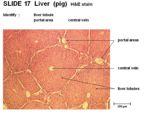Difference between revisions of "Liver - Anatomy & Physiology"
Jump to navigation
Jump to search
| Line 7: | Line 7: | ||
The size of the liver varies due to its role in metabolism. In carnivores the liver weighs about 3-5% of body weight, in omnivores 2-3% and in herbivores 1.5%. the liver is much heavier in young animals rather than older animals as it atropies with age. | The size of the liver varies due to its role in metabolism. In carnivores the liver weighs about 3-5% of body weight, in omnivores 2-3% and in herbivores 1.5%. the liver is much heavier in young animals rather than older animals as it atropies with age. | ||
| − | |||
| − | |||
| Line 74: | Line 72: | ||
==Histology== | ==Histology== | ||
| − | * | + | [[Image:Lobule Histology.jpg|thumb|right|150px|Liver Lobule Histology - Copyright RVC 2008]] |
| + | *Connective tissue capsule around each lobule | ||
| + | |||
| + | *The larger liver cells are called lobules | ||
| + | **Each lobule contains an opening for the central vein and contains portal areas | ||
| + | **Lobules composed of liver cords called hepatocytes | ||
| + | **Sinusoids present between hepatocytes | ||
| + | |||
| + | *Portal area present in lobules | ||
| + | ** | ||
| + | |||
Revision as of 14:48, 10 July 2008
Introduction
The liver (hepar) is an extremely important organ in the body of mammals and vertebrates which provides functions essential for life. It is the largest internal organ and has numerous functions including production of bile and protein, fat and carbohydrate metabolism.
The size of the liver varies due to its role in metabolism. In carnivores the liver weighs about 3-5% of body weight, in omnivores 2-3% and in herbivores 1.5%. the liver is much heavier in young animals rather than older animals as it atropies with age.
Structure
- Cranial part of the abdomen
- Immediately caudal to the diaphragm
- Cranial to the stomach and intestines
- Generally the bulk of the liver on the right of the midline
- Divided into lobes by fissures
- Cranially the liver is convex, called the diaphragmatic surface
- Caudally the liver is concave, called the visceral surface
- Caudate lobe has a renal impression from the right kidney
- Passgaes or notches on the median plane allow the caudal vena cava and oesophagus to pass by
- The gallbladder is located between the right medial and quadrate lobes
- The hiatus is
Lobes of the Liver
- Left lateral
- Left medial
- Right lateral
- Right medial
- Quadrate
- Caudate
- Papillary
Function
Vasculature
Innervation
Lymphatics
Histology
- Connective tissue capsule around each lobule
- The larger liver cells are called lobules
- Each lobule contains an opening for the central vein and contains portal areas
- Lobules composed of liver cords called hepatocytes
- Sinusoids present between hepatocytes
- Portal area present in lobules
Species Differences
Canine
- Conical bluntly
